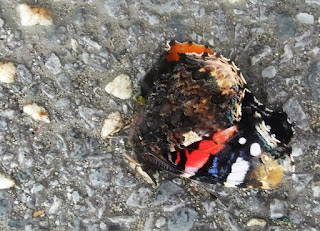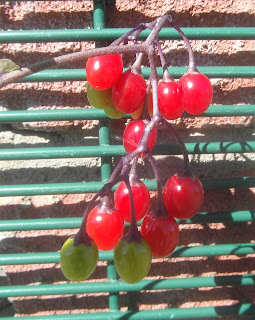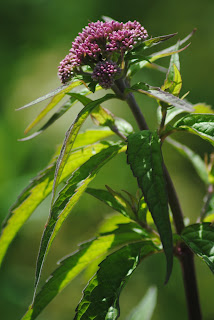This blog may help people explore some of the 'hidden' issues involved in certain media treatments of environmental and scientific issues. Using personal digital images, it's also intended to emphasise seasonal (and other) changes in natural history of the Swansea (South Wales) area. The material should help participants in field-based modules and people generally interested in the natural world. The views are wholly those of the author.
Sunday, 31 July 2016
Thursday, 28 July 2016
Heads in the Sand in Ayrshire?
There is a report (https://theguardian.com/world/2016/jul/27/ostriches-on-the-loose-in-scottish-village-patna) that an ostrich (or ostriches?) is (are) roaming the countryside around the Ayrshire village of Patna. This has caused much excitement as an ostrich can disembowel animals it regards as a threat with a single kick. It has also been pointed out that mother ostriches (the more dowdy bird) can be very defensive when protecting their chicks (and there was been speculation about whether the escaped bird has chicks). After initial vagueness about where the bird(s) came from, one resident has apparently admitted that a bird has gone AWOL. I wonder if it qualifies as a dangerous animal?
Not to be Sniffed At?
The rise and rise of antibiotic-resistant bacteria (like MRSA and VREF) have threatened a return to an age where bacterial infections could not be effectively treated and people died from minor infections.This is largely a consequence of the fact that using antibiotics exerts selection pressure on rapidly dividing bacterial populations, resulting in the resistance being rapidly acquired. This has not been helped by over-prescription of antibiotics (they do not work on viruses) and their employment in farming to encourage growth in animal stocks. Most of the existing antibiotics have copied the chemicals used by some micro-organisms to out-compete their bacterial rivals (penicillin is one used by a fungus). There is now a report that a new antibiotic that is effective against MRSA is produced by a commensal ('friendly') bacterium that lives in the human nose (https://theguardian.com/society/2016/jul/27/scientists-sniff-out-new-antibiotic-inside-the-human-nose-mrsa). It is, of course, likely that many of our regular bacterial residents (including those in our large intestines) will prove to be sources of medically useful compounds. The 'war' between the development of new antibiotics (often not especially attractive to drug companies, if they are little used) and the development of bacterial resistance is likely to be never-ending.
Tuesday, 26 July 2016
Rats!
News that the New Zealand government intends to develop a programme to eliminate all alien predators seems a tad optimistic ( https://www.theguardian.com/world/2016/jul/25/no-more-rats-new-zealand-to-exterminate-all-introduced-predators). The focus is on rats along with stoats and possums as these appear to be responsible for losses of ground-nesting indigenous birds including the kiwi. Such anthropogenic (caused by we humans) effects of accidentally/deliberately introduced alien species are a major challenge to fragile ecologies in many parts of the globe but many experiences suggest that eradications (even on tiny islands without substantial human constructions) are not at all easy, cheap or fast. New Zealand is diverse, reasonably substantial and would, I feel, be a difficult nut to crack. It's a good aspiration but I'm not sure whether it's achievable. Rats, for a start, are pretty adaptable (they can climb and operate in burrow systems as exhibit bait shyness). One might also ask whether companion predators such as domestic cats and dogs- they can become feral and would be just as much a problem- have been considered?
Monday, 25 July 2016
Saturday, 23 July 2016
Friday, 22 July 2016
Thursday, 21 July 2016
D Day Everyday?
News that medics are recommending that all people in the UK should consider taking vitamin D supplements, especially over the period October to April (http://www.bbc.co.uk/news/health-36846894). Vitamin D is basically a hormone produced under the skin when exposed to UV light. It is important in terms of regulating the health of bones, teeth and muscle (a severe, chronic deficiency causes Rickets) by its effects on the uptake and retention of calcium ion. The trouble is, that if you live in northerly locations, the sun does not provide enough UV in the winter months to stimulate production of the hormone (this is especially true if you rarely go outside or routinely cover up). The alternative is to get your vitamin D in the diet (from oily fish, eggs and 'added-to' cereals). It is argued that people may not always achieve a sufficient intake of vitamine D by this route and should consider popping the pills. An alternative, for some, might be to put in place special lamps in houses and work places that produce UV (this is done for captive reptiles in some zoos). It does seem to be rather a large change to advocate.
Monday, 18 July 2016
Saturday, 16 July 2016
Friday, 15 July 2016
Confirmation: There are B-all Butterflies
A report confirms that 2016 might well be the worst year for butterfly species in the UK since attempts were made to quantify numbers and species (https://theguardian.com/environment/2016/jul/15/2016-could-be-worst-year-on-record-for-british-butterflies-experts-warn). So I was not imagining things. I post some images to remind us of what we are missing!
Thursday, 14 July 2016
Moth Balls?
News received that the day-flying Silver 'Y' moths (Autographa gamma) that disrupted the UEFA cup final are on their way from Paris to the UK (https://www.theguardian.com/environment/2016/jul/13/euro-2016-moths-paris-to-britain). A sort of reverse Brexit?
Wednesday, 13 July 2016
Seeing the Changes 1098
After complaining about butterfly dearths yesterday, I did spot a Comma (Polygonia c-album) in Bynea. I also briefly saw a Small tortoiseshell (Aglais urticae) in the same location- it appeared to be a bit smaller than usual. A Garden chafer (Phyllopertha horticola) landed on my drying jeans in Loughor.
Tuesday, 12 July 2016
Monday, 11 July 2016
Sunday, 10 July 2016
Thursday, 7 July 2016
Monday, 4 July 2016
Keep Off the Grass!
UK conservationists have expressed concern that, a recent trend to replace garden lawns with plastic alternatives (as is common in parched areas of the USA), is likely to have very detrimental effects on our urban wildlife (https://www.theguardian.com/environment/2016/jul/04/growth-in-artificial-lawns-poses-threat-to-british-wildlife-conservationists-warn). These artificial lawns (reportedly used at some prestigious garden exhibitions) will not only alter the drainage of a substantial part of the unbuilt and unfarmed land mass in the UK but, of course, provide no food for insects, molluscs, birds and mammals. I can see the attraction of not having to treat, mow or water the 'green carpet' outside our homes (just like the areas already converted for car parking?) but do hope as many people as possible will keep the grass. It's not only humans that live in towns.
Sunday, 3 July 2016
Seeing the Changes 1093
Lots of developments at NWCW with the flowering of Greater knapweed (Centaurea scabiosa); profuse Common figwort (Scrophularia nodosa); Hemp agrimony (Eupatorium cannabinum); Wild clary (Salvia verbenaca); Marsh bedstraw (Galium palustre) and Broom (Cytisus scoparius). Insects were also about with Rhagonycha fulva beetles and Tabanus bovinus horse-flies.
Saturday, 2 July 2016
Friday, 1 July 2016
Subscribe to:
Comments (Atom)
It's All Downhill Now
The snowline is climbing in the French Alps. This has resulted, thus far, in the closure of 186 ski resorts. This figure is like...

-
I n the UK and US, a pparently popular and successful vegan/vegetarian restaurants are reportedly closing or adding meat to their menus ( ...
-
Early ripening fruit may seem convenient but some folk think it confirms environmental stress. There's also a possibility th...










































%20mating%20NWCW.jpg)

